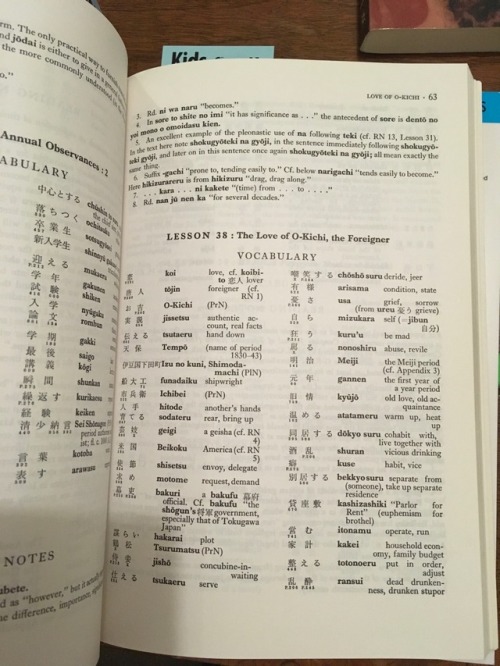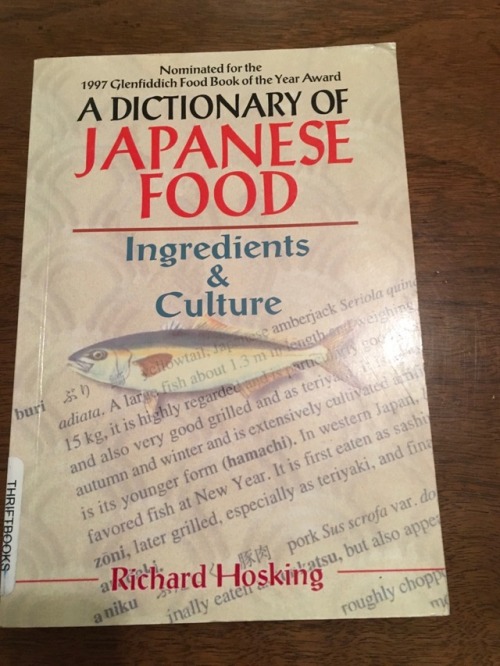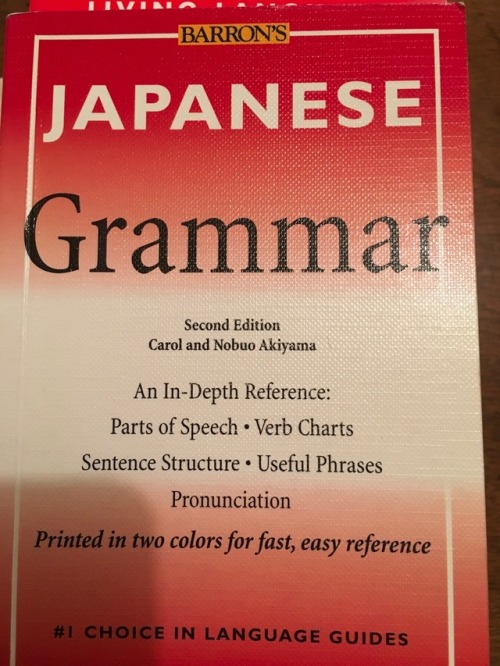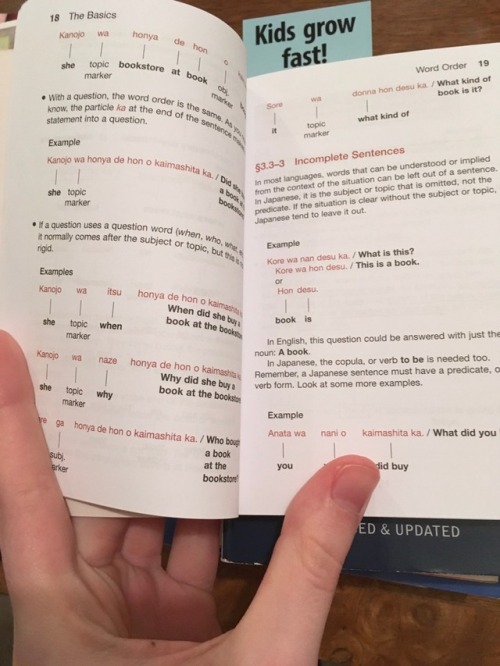redbirds-and-kingfishers:Alright, I had a post on Instagram displaying my treasure trove of Japane
redbirds-and-kingfishers: Alright, I had a post on Instagram displaying my treasure trove of Japanese language learning books. I wanted to show off a few of them and talk about all of them. The first photo displays them all (tumblr limited me to 10 photos only, so I’ll discuss some of them without photos, sorry!). Starting from the bottom of the pile: 1. Kanji Power by Tuttle. It’s what you think it is, a kanji workbook. It has a kanji, a mnemonic, some space to practice writing, on'yomi, kun'yomi, stroke order, and some vocabulary/phrases. It has some kanji not covered in my other kanji books. 2. If You Teach Me Japanese, I’ll Teach You English. It’s a strange little book and it’s taking me a while to get the hang of it, but this book was written specifically for language exchanges. Each lesson is done first in Japanese, then again in English. You and your partner serve as the “teacher” in your native language, while you practice that language. So I would read through as the instructor in the English lesson and guide my partner with the scripted dialogues, helping them along the way so that they learn English. They would do vice versa for me with the Japanese. I got this one specifically to aid me in exchanging my language with my partners. They do great with the Japanese and I needed guidance on how to help them with English. So this one isn’t really to learn Japanese, it’s to help me exchange with my Japanese friends. 3. Japanese Step by Step. This is one of the few books that focuses on teaching you SPEAKING Japanese. Most of my books help in reading, writing and I’m having to supplement with Memrise and YouTube for listening and speaking. This book has very easy to understand lessons, starting with syllables not syllabaries. Shows you in English what they’re trying to teach you in Japanese. So it’s almost like learning in parallel, I’m not explaining it well. It’s a really good book, you should just check it out. 4. Beginning Japanese by Yale University Press. This was originally my Dad’s book that he used to teach himself Japanese since he was being stationed there (way back in ye olden days). He very kindly gave it to me. This book also focuses on SPEAKING Japanese, not reading or writing in it. As such, it’s entirely in romaji! Not ideal, but if you just want to focus on speaking the language, this is a good place to start. Very thorough. 5. Reading Japanese by Yale University Press. Same authors as book #4, but not originally my Dad’s. Since this one is focused on READING (hence the title of the book), it is not in entirely in romaji. Whew! What a relief. I just got it today, so I have no feedback other than, I wanted both of these books together. It’s kind of like an entire course at your fingertips. 6. Japanese Kanji for Beginners by Tuttle. Covers JLPT N5 & N4. This is my primary Kanji workbook. I LOVE it. It’s set up pretty much the same as Kanji Power, it has exercises after each lesson so you can practice what you learned. The Kanji Power has the same things, but after a certain number of kanji have been introduced, instead of after each individual lesson. So they differ that way and in that they have different kanji. This book is specifically for JLPT N5/4 whereas Kanji Power is about expanding your kanji. 7. A Japanese Reader by Tuttle (notice the theme?). Pictures 2-4 are about this book. I cannot say enough nice things about this book! The book is split in two; open it like we open all books in the Western Hemisphere and it’s lessons starting with hiragana, open the book the other way and it’s all the reading lessons: from top to bottom and right to left! It’s so cool! The first few elementary readings aren’t actual sentences. They’re just to get you accustomed to the style of reading and the syllabaries (this is where I’m at). The readings get way more advanced though and are excerpts from Japanese literature, some fictional and some non-fictional. 8. A History of Japan. This is another one of Dad’s book that he is lending to me (sadly I don’t get to keep it). I haven’t read it yet but I’m looking forward to it. Granted, it has nothing to do with the language itself, but who here has learned a language without learning anything about the culture, history, and society of the country that speaks the language? Half the point of learning a language is to learn the history and culture of the target language’s country. So I have a book on Japan’s history to supplement the language learning. 9. A Dictionary of Japanese Food by Tuttle. Pictures 5 & 6 are of this book. Just as I stated in the above book, it’s important to know the culture and history of the place whose language you are learning. The “Japanese Kanji for Beginners” book had an exercise in the first lesson involving food. One of the dishes stood out to me because I had no clue what it was “shabu-shabu.” I still don’t know what it is, but now I have a dictionary so I can look it up! If ever I learn how to cook Japanese food, shabu-shabu will be very near the top of the list of things to make and try. The back of the book has some appendices on chopsticks, some ingredients of Japanese food, and food etiquette. 10. The Handbook of Japanese Verbs (picture 7). Verbs seem to be the guts of a sentence in Japanese so I figured it’d be important to learn them a little more in depth than my grammar book goes into. Besides explaining verbs, it has exercises to practice! 11. All About Particles (picture 8). Much like the verb book above, this is all about particles (another very important part of the Japanese language) and also has exercises to help you grasp the concepts. Goes in depth about the particles and actually has sentences in Japanese, literal translations, and English translations. It’s very thorough. 12. Japanese Coursebook by Living Language. Akin to the Yale University Press books that I covered earlier, this book is a complete course for learning how to SPEAK Japanese. As such, it is entirely in romaji but is set up different than the Yale books and has different vocabulary. I use them in conjunction with each other, so that I get the most vocabulary overall. 13. Japanese Grammar by Barron. Pictures 9 & 10 are of this book. This is my absolute favorite book out of them all. Besides being pocket-sized so I can take it just about anywhere with me, it’s a grammar book. I’m not a Grammar Nazi, I’m a Grammarian (one who studies grammar [on purpose]). I read grammar books for my native English and I greatly enjoy grammar for Ancient Greek too (my first foreign language and first true love). All the other books focus on a particular portion of grammar, or the writing system, or speaking. I wanted a book that focused entirely on grammar since I’ve heard it’s so vastly different from English (it’s not THAT different guys). As you can see in the very last picture, the book is printed in two colors. I cannot begin to express how wonderful this is for me. I have Scotopic Sensitivity Syndrome (SSS or 3S) and basically what that means is, my eyes don’t work right (duh). They don’t pick up all the wavelengths of light that they’re supposed to. So some colors (and light sources) are harder for me to see and make me very sick trying to look at them. It seems like I have dyslexia but it’s not my brain, it’s just my eyes suck. The added color is much easier on my eyes than all black print on white pages (college was nightmare, in case you wondered). Last book, 14. Kanji Starter 1. Not a lesson book at all! It has 200 kanji and is essentially a book of mnemonics for them. I use it as a catalog and mark the kanji I’ve mastered from other sources in this book. I also use it as a quick reference when I get suddenly forget a kanji I’ve already learned. That way I don’t have to find the right lesson book and track it down. I got this kanji book before any of the others and it served as the introduction to what i was getting myself into. It made the kanji seem so not scary that by the time I picked up a workbook, kanji was beautiful, logical, and fun. No fear! Sorry this was so long. I’m on a mobile device so I can’t do the nice “keep reading” breaks or formatting. So it’s just a really long, darn post. But now you know of 14 books you can use for Japanese learning! Also, quick note, all of the books with bar code stickers on them were all purchased form the same site. ThriftBooks.com has so many books, including rare ones, old, ones, and textbooks, for a fraction of the price. I looked up some of my Tuttle books, one of them was like $19.95 normally (without shipping and tax). On ThriftBooks I got it for $3.50! If your total purchase is over $10 shipping is entirely free too. So if you’re looking for language resources, a new novel, or you’re in college and need textbooks, check the site out because it might save you a boat-load of money. -- source link
Tumblr Blog : www.tumblr.com
#references#japanese language#日本語









